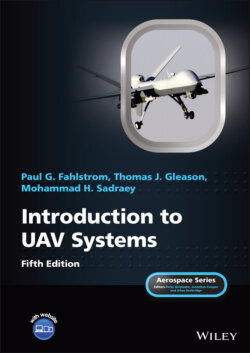Читать книгу Introduction to UAV Systems - Mohammad H. Sadraey - Страница 57
2.3 Examples of UAVs by Size Group
ОглавлениеWe attempt here to provide a broad survey of the many types of UAVs that have been or are being designed, tested, and fielded throughout the world. The intent of this survey is to introduce those who are new to the UAV world to the wide variety of systems that have appeared over the few decades since the revival of interest in UAVs began in the 1980s.
There are a variety of guides to UAVs available and a great deal of information is posted on the Internet. We use The Concise Global Industry Guide [6] as a source for quantitative characteristics of current UAVs and a variety of open‐source postings and our own personal files for information on systems no longer in production.
As a general organizing principle, we will start with the smallest UAVs and proceed to some that are the size of a corporate jet. The initial efforts on UAVs in the 1980s concentrated on AVs that had typical dimensions of 2 or 3 m (6.6–9.8 ft), partly driven by the need to carry sensors and electronics that at that time had not reached the advanced state of miniaturization that has since become possible. In more recent years, there has been a growing interest in extending the size range of UAVs down to insect‐sized devices at one extreme and up to medium air transport sizes at the other end.
Some of the motivation for smaller UAVs is to make them man portable so that a soldier or a border guard can carry, launch, and control a model‐airplane‐sized UAV that allows him or her to take a look over the next hill or behind the buildings that are in front of him or her. Further miniaturization, to the size of a small bird or even an insect, is intended to allow a UAV to fly inside a building or perch unnoticed on a window sill or roof gutter and provide a look inside the building or into a narrow street.
The realm of small UAVs is one in which there is no competition from manned vehicles. It is unique to vehicles that take advantage of the micro‐miniaturization of sensors and electronics to allow humans to view the world from a flying vehicle that could land and take off from the palm of their hand and can go places that are not accessible to anything on a human scale.
The motivation for larger UAVs is to provide long endurance at high altitudes with the ability to fly long distances from a base and then loiter over an area for many hours using a larger array of sensors to search for something or keep watch over some area. Increasingly, in the military arena, the larger UAVs also provide a capability to carry a large weapons payload a long distance and then deliver it to the destination area.
There now is increasing talk about performing missions such as heavy air transportation, bombers, and even passenger transportation with unmanned systems. Whatever may be the outcome of those discussions, it is likely that there eventually will be unmanned systems of all sizes.
In the following sections, we use intuitive‐size classes that are not in any sense standardized but are convenient for this discussion. In the next six sections, general features of micro, mini, very small, small, medium, and large UAVs are presented.
